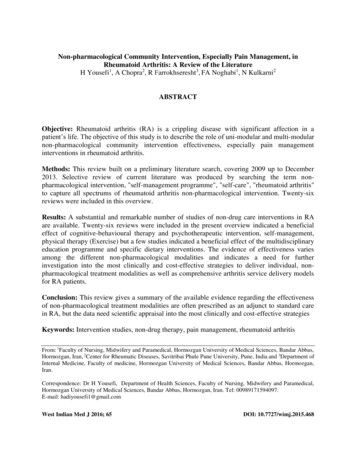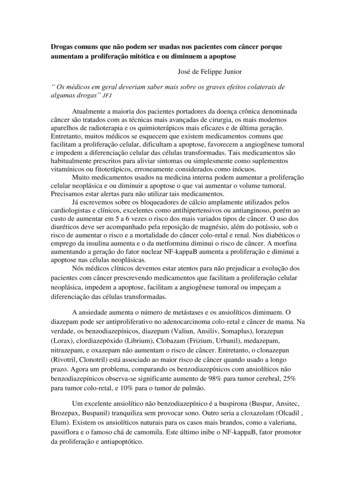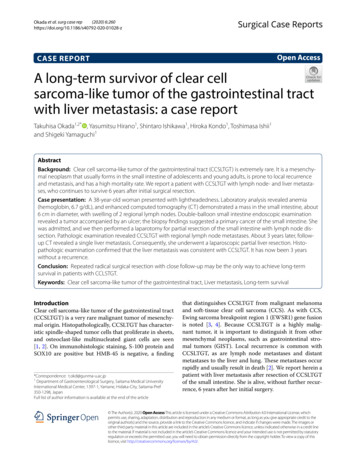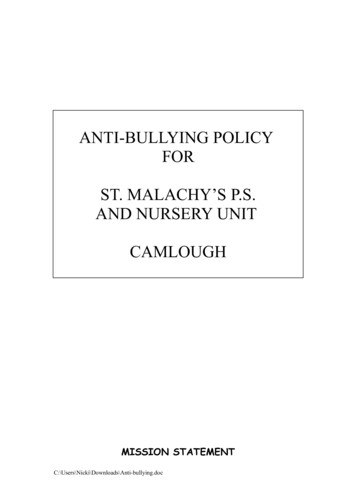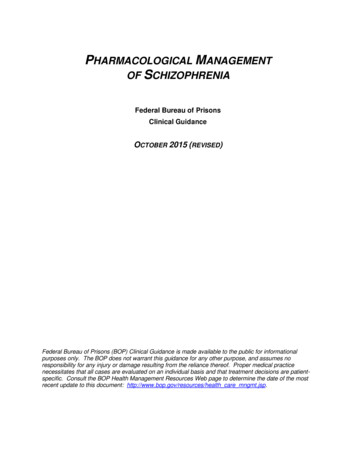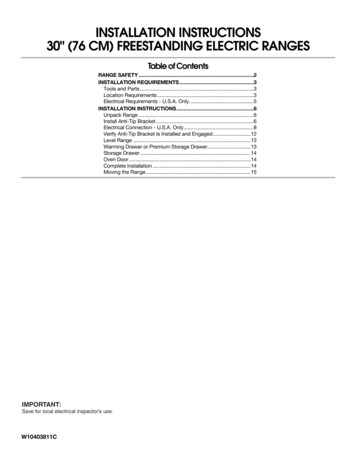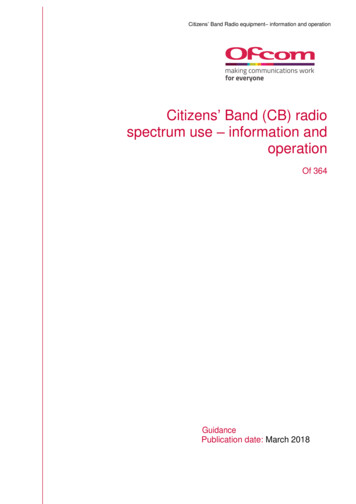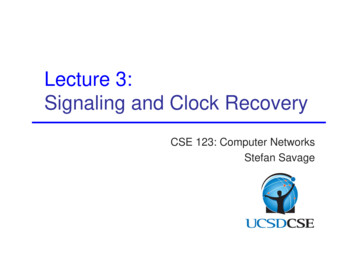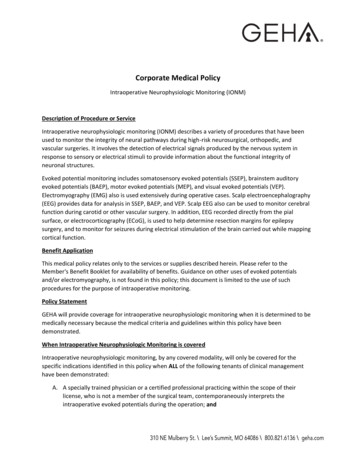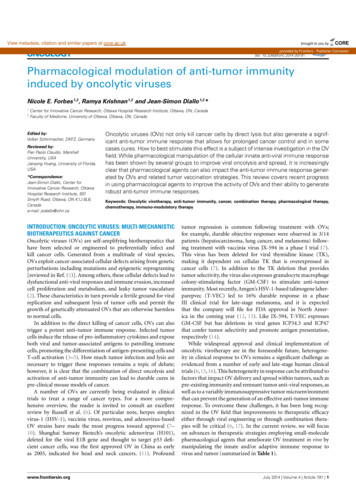
Transcription
View metadata, citation and similar papers at core.ac.ukbrought to you byREVIEW ARTICLECOREpublished:23 Julyby2014providedFrontiers - Publisher Connectordoi: 10.3389/fonc.2014.00191Pharmacological modulation of anti-tumor immunityinduced by oncolytic virusesNicole E. Forbes 1,2 , Ramya Krishnan 1,2 and Jean-Simon Diallo 1,2 *12Center for Innovative Cancer Research, Ottawa Hospital Research Institute, Ottawa, ON, CanadaFaculty of Medicine, University of Ottawa, Ottawa, ON, CanadaEdited by:Volker Schirrmacher, DKFZ, GermanyReviewed by:Pier Paolo Claudio, MarshallUniversity, USAJianping Huang, University of Florida,USA*Correspondence:Jean-Simon Diallo, Center forInnovative Cancer Research, OttawaHospital Research Institute, 501Smyth Road, Ottawa, ON K1J 8L6,Canadae-mail: jsdiallo@ohri.caOncolytic viruses (OVs) not only kill cancer cells by direct lysis but also generate a significant anti-tumor immune response that allows for prolonged cancer control and in somecases cures. How to best stimulate this effect is a subject of intense investigation in the OVfield. While pharmacological manipulation of the cellular innate anti-viral immune responsehas been shown by several groups to improve viral oncolysis and spread, it is increasinglyclear that pharmacological agents can also impact the anti-tumor immune response generated by OVs and related tumor vaccination strategies. This review covers recent progressin using pharmacological agents to improve the activity of OVs and their ability to generaterobust anti-tumor immune responses.Keywords: Oncolytic virotherapy, anti-tumor immunity, cancer, combination therapy, pharmacological therapy,chemotherapy, immuno-modulatory therapyINTRODUCTION: ONCOLYTIC VIRUSES: MULTI-MECHANISTICBIOTHERAPEUTICS AGAINST CANCEROncolytic viruses (OVs) are self-amplifying biotherapeutics thathave been selected or engineered to preferentially infect andkill cancer cells. Generated from a multitude of viral species,OVs exploit cancer-associated cellular defects arising from geneticperturbations including mutations and epigenetic reprograming[reviewed in Ref. (1)]. Among others, these cellular defects lead todysfunctional anti-viral responses and immune evasion, increasedcell proliferation and metabolism, and leaky tumor vasculature(2). These characteristics in turn provide a fertile ground for viralreplication and subsequent lysis of tumor cells and permit thegrowth of genetically attenuated OVs that are otherwise harmlessto normal cells.In addition to the direct killing of cancer cells, OVs can alsotrigger a potent anti-tumor immune response. Infected tumorcells induce the release of pro-inflammatory cytokines and exposeboth viral and tumor-associated antigens to patrolling immunecells, promoting the differentiation of antigen-presenting cells andT-cell activation (3–5). How much tumor infection and lysis arenecessary to trigger these responses remains a topic of debate;however, it is clear that the combination of direct oncolysis andactivation of anti-tumor immunity can lead to durable cures inpre-clinical mouse models of cancer.A number of OVs are currently being evaluated in clinicaltrials to treat a range of cancer types. For a more comprehensive overview, the reader is invited to consult an excellentreview by Russell et al. (6). Of particular note, herpes simplexvirus-1 (HSV-1), vaccinia virus, reovirus, and adenovirus-basedOV strains have made the most progress toward approval (7–10). Shanghai Sunway Biotech’s oncolytic adenovirus (H101),deleted for the viral E1B gene and thought to target p53 deficient cancer cells, was the first approved OV in China as earlyas 2005, indicated for head and neck cancers. (11). Profoundwww.frontiersin.orgtumor regression is common following treatment with OVs;for example, durable objective responses were observed in 3/14patients (hepatocarcinoma, lung cancer, and melanoma) following treatment with vaccinia virus JX-594 in a phase I trial (7).This virus has been deleted for viral thymidine kinase (TK),making it dependent on cellular TK that is overexpressed incancer cells (7). In addition to the TK deletion that providestumor selectivity, the virus also expresses granulocyte macrophagecolony-stimulating factor (GM-CSF) to stimulate anti-tumorimmunity. Most recently, Amgen’s HSV-1-based talimogene laherparepvec (T-VEC) led to 16% durable response in a phaseIII clinical trial for late-stage melanoma, and it is expectedthat the company will file for FDA approval in North America in the coming year (12, 13). Like JX-594, T-VEC expressesGM-CSF but has deletions in viral genes ICP34.5 and ICP47that confer tumor selectivity and promote antigen presentation,respectively (14).While widespread approval and clinical implementation ofoncolytic virotherapy are in the foreseeable future, heterogeneity in clinical response to OVs remains a significant challenge asevidenced from a number of early and late-stage human clinicaltrials (6, 15, 16). This heterogeneity in response can be attributed tofactors that impact OV delivery and spread within tumors, such aspre-existing immunity and remnant tumor anti-viral responses, aswell as to a variably immunosuppressive tumor microenvironmentthat can prevent the generation of an effective anti-tumor immuneresponse. To overcome these challenges, it has been long recognized in the OV field that improvements to therapeutic efficacyeither through viral engineering or through combination therapies will be critical (6, 17). In the current review, we will focuson advances in therapeutic strategies employing small-moleculepharmacological agents that ameliorate OV treatment in vivo bymanipulating the innate and/or adaptive immune response tovirus and tumor (summarized in Table 1).July 2014 Volume 4 Article 191 1
Forbes et al.Pharmacological modulation of OV therapyTable 1 Combinations of pharmacological and oncolytic therapies with demonstrated improvements in in vivo treatment efficacy.DrugMechanism ofReported immunomodulatoryOncolyticaction/moleculareffect (systemic immunomodula-virustargettion or specific modulation ofReferenceanti-viral responseCLASSIC CHEMOTHERAPY AGENTSCyclophosphamideDNA alkylationSystemic immunomodulationHSVIkeda et al. (20), Ikeda et al. (21),Wakimoto et al. (22), and Currier et al. (24)AdenovirusThomas et al. (25), Dhar et al. (26), CerulloVacciniaLun et al. (29)ReovirusQiao et al. (30) and Kottke et al. (34)MeaslesUngerechts et al. (31) and Ungerechtset al. (27), and Hasegawa et al. (28)et al. (32)GemcitabineNucleoside substitutionSystemic immunomodulationAdenoviruset al. (40), Bhattacharyya et al. (41),replication,Cherubini et al. (42), Wang et al. (43), andribonucleotideParvovirusreductase inhibitorBortezomibLeitner et al. (38), Liu et al. (39), Onimaruand inhibition of DNAProteasome inhibitionSystemic immunomodulationKangasniemi et al. (44)Angelova et al. (45)ReovirusGujar et al. (48)VSVHastie et al. (49)HSVWatanabe et al. (50) and Esaki et al. (51)VacciniaYu et al. (52)MyxomaWennier et al. (53)VSV (VSV-mIFNβ)Yarde et al. (61)ReovirusCarew et al. (62)AdenovirusBoozari et al. (63)(hTERT-Ad)MitoxantroneType II topoisomeraseSystemic immunomodulationHSVWorkenhe et al. (69)systemic immunomodulationHSVSindbisTyminski et al. (74)Granot and Meruelo (75)Systemic immunomodulationAdenovirusAlonso et al. (80), Holzmuller et al. (81),HSVAghi et al. (84) and Kanai et al. (85)HSVOtsuki et al. (106)inhibitionIrinotecanType I topoisomeraseinhibitionTemozolomideDNA alkylationLiikanen et al. (82), and Tobias et al. (83)EPIGENETIC MODULATORSValproic acidTrichostatin AEntinostat (MS-275)Histone deacetylaseSpecific modulation of anti-viralinhibitionresponseHistone deacetylaseSpecific modulation of anti-viralinhibitionresponseHSVVacciniaLiu et al. (105)MacTavish et al. (108)Histone deacetylaseBothVSVNguyen et al. (99) and Bridle et al. (109)DNA methyltransferaseSpecific modulation of anti-viralHSVOkemoto et al. (111)inhibitionresponseHSVKanai et al. (116)inhibition5-AzacitidinePI3K/Akt/mTOR PATHWAY INHIBITORSLY294002PI3K inhibitionSpecific modulation of anti-viralresponse(Continued)Frontiers in Oncology Tumor ImmunityJuly 2014 Volume 4 Article 191 2
Forbes et al.Pharmacological modulation of OV therapyTable 1 ContinuedDrugMechanism ofReported immunomodulatoryOncolyticaction/moleculareffect (systemic immunomodula-virustargettion or specific modulation ofReferenceanti-viral responseRapamycinmTORC1 and mTORC2BothAdenovirusHSVJiang et al. (120)Fu et al. (121)VSVAlain et al. (122)BothAdenovirusLukashev et al. (119)Specific modulation of anti-viralVSVDiallo et al. (125)VSVBen Yebdri et al. (130)VSVReovirusKottke et al. (87) and Jha et al. (88)Kottke et al. (87)VacciniaHou et al. (89)NDVZamarin et al. (138)inhibitionEverolimusmTORC1 inhibition(RAD001)OTHERViral sensitizer 1Unknown(VSe1)TriptolideresponseGlobal transcriptionSpecific modulation of anti-viralinhibition via RNA pol IIresponseinhibitionSunitinibIpilimumabReceptor tyrosineSpecific modulation of anti-viralkinase inhibitionresponseCTLA-4 inhibitionSystemic immunomodulationNumerous studies have shown that combining oncolytic virotherapy and pharmacological therapy leads to improved outcomes in vivo. This table summarizes thesereports, presenting the small molecule used in the study, its main mechanism of action or molecular target, its reported immuno-modulatory effect(s), and type ofoncolytic virus used. Abbreviations: HSV, herpes simplex virus; VSV, vesicular stomatitis virus; mIFNβ, murine interferon beta; hTERT-Ad, human telomerase reversetranscriptase promoter-regulated adenovirus; PI3K, phosphoinositide 3-kinase; mTOR, mammalian target of rapamycin; mTORC1, mammalian target of rapamycincomplex 1; mTORC2, mammalian target of rapamycin complex 2; CTLA-4, cytotoxic T-lymphocyte antigen 4.STANDARD CHEMOTHERAPEUTIC DRUGS THAT BOOST OVACTIVITY THROUGH SYSTEMIC EFFECTS ON IMMUNE CELLSAND THE IMMUNE RESPONSEMost cancer patients with advanced disease will be subjected tosome form of chemotherapy. This will largely depend on thetype of cancer and other salient pathophysiological characteristics. Given that most patients enrolled in clinical trials to testthe efficacy of OVs suffer from advanced disease (7), a naturaltrend in the OV field has been to test OVs in combination withchemotherapeutics that are currently the standard of care. Classicchemotherapy drugs typically capitalize on the fact that cancer cellsare continuously replicating unlike most normal cells (18). However, some normal cell types have higher replication rates, leadingto significant off-target effects. Hematopoietic cells among otherscan be affected and this can lead to systemic immunosuppression (discussed below). While the evaluation of chemotherapeuticdrugs in the context of OV therapy has been fairly empiricalfor the most part, their immunosuppressive effects can inherently complement OV activity by increasing OV spread withintumor beds and/or increasing anti-tumor immune responses. Thefollowing sections provide an overview of classic chemotherapydrugs that have been evaluated in combination with OVs focusingon their anti-cancer mechanism of action, examples of OVs withwhich they have been tested, and the mechanism by which theseagents suppress immunity and co-operate with OVs to improvetherapeutic hosphamide (CPA) is a nitrogen mustard alkylating agentthat leads to cross-linking of nucleotides. Its active metabolite, phosphoramide mustard, interferes with DNA replicationby forming guanine-to-guanine intra-strand and inter-strandcrosslinks (19). Aldehyde dehydrogenase (ALDH) catalyzes theconversion of the immediate precursor of phosphoramide mustard, aldophosphamide, to an inactive metabolite. Normal cells,for example intestinal epithelial cells and bone marrow stem cells,have a high level of ALDH, protecting them from the effectsof CPA’s toxic metabolites. In contrast, some lymphocytes havea lower level of ALDH, which makes them more susceptible tothe effects of CPA. CPA has been used in combination with several OVs including HSV-1 (20–24), adenovirus (25–28), vaccinia(29), reovirus (30), measles (31–33), and vesicular stomatitis virus(VSV) (33), leading to improved anti-tumor activity in vivo. Several studies suggest that CPA can be efficacious in combinationwith OVs by preventing immune-mediated viral neutralizationthrough inhibiting or delaying the rise of neutralizing antibodies and depleting anti-viral immune cells including natural killer(NK) cells, monocytes, macrophages, and lymphocytes (20, 22, 23,25, 26). For example, one study showed that CPA inhibits tumorinfiltration of innate phagocytes (macrophages, microglia, and NKcells) following HSV treatment in a syngeneic rat glioma model,leading to increased viral persistence and improved overall efficacy(23). Other studies suggest CPA can also enhance the generation ofJuly 2014 Volume 4 Article 191 3
Forbes et al.anti-tumor immunity by inhibiting regulatory T-cells (Tregs) (27,34). Results from a first in-human clinical trial using Ad-GM-CSF(CGTG-102) to treat solid tumors suggest that metronomic dosing of CPA decreases Tregs without compromising the induction ofanti-tumor T-cell responses. This was found to be associated withincreased cytotoxic T-cell responses and the induction of Th1 typeimmunity in most patients. The best progression-free survival andoverall patient survival rates were seen with the combination ofmetronomic CPA and intratumoral infection of adenovirus (27).GEMCITABINEGemcitabine is a fluorinated deoxycytidine nucleoside analog.Incorporation of this analog into DNA prevents further addition of nucleosides during DNA polymerization and thereby haltsDNA replication and cell division. Gemcitabine also binds irreversibly to the active site of ribonucleotide reductase. As a result,nucleotide production is halted and DNA replication ceases, leading to apoptosis in rapidly dividing cells [reviewed in Ref. (35)].While gemcitabine can decrease neutralizing antibodies similar toCPA (36), it is thought to promote anti-tumor immune responsesby off-target elimination of myeloid derived stem cells (MDSCs),which suppress T-cell responses. Gemcitabine treatment therebyincreases the activity of CD4 and CD8 T-cells that recognize tumor antigens (37). This drug has been shown to increasethe anti-tumor activity of a wide array of OVs including adenovirus (38–44), parvovirus (45, 46), reovirus (47, 48), VSV (49),HSV (50, 51), vaccinia (52), and myxoma virus (53). In the latter example, the anti-cancer activity of oncolytic myxoma viruswas improved using gemcitabine in disseminated pancreatic cancer murine models (53). Interestingly, no sensitization occurredin immunocompromised mice, supporting the requirement fora virus-triggered anti-tumor immune response in mediating thecombination effect. The combination of gemcitabine and reoviruswas recently evaluated in a phase I clinical trial and while antitumor immune responses were not measured, neutralizing antibodies against reovirus were decreased by gemcitabine treatment.In this study, 80% of evaluable patients showed either partialresponse or stable disease (36).BORTEZOMIBBortezomib is a proteasome inhibitor approved to treat multiplemyeloma and mantle cell lymphoma. It reversibly binds the catalytic site of the 26S proteasome with high affinity and specificity(54). Bortezomib has been shown to inhibit NF-κB by preventingdegradation of IκB-α in some cell types (55) although the oppositeeffect has also been observed (56). Other mechanisms of action bywhich bortezomib may kill cancer cells are through ER-stress andactivation of the unfolded protein response (UPR) (57) and triggering apoptosis by preventing the degradation of pro-apoptoticproteins (56, 58). Some studies have shown that treatment of cancer cells using bortezomib increases surface expression of Hsp90and Hsp60 in cancer cells leading to their more effective phagocytosis by dendritic cells (DCs), improving tumor vaccine effects(59). Bortezomib-treated mice also exhibit increased DC maturation and phagocytic potential (59). On the other hand, onestudy found that bortezomib treatment leads to apoptosis ofFrontiers in Oncology Tumor ImmunityPharmacological modulation of OV therapyallo-reactive CD4 T-cells. Thus the net result on anti-cancer andanti-viral immune responses is likely context-dependent (60).Bortezomib has been tested in combination with oncolyticVSV (61), reovirus (62), and adenovirus (63). Using VSV-mIFNβ,combined treatment with bortezomib was inhibitory to virusreplication in myeloma cells in vitro but led to improved therapeutic efficacy compared to single treatments in syngeneic murinemyeloma models (61). Given no observed effect on tumor viralload, this suggests bortezomib likely increases virus-induced celldeath and/or potentiates the anti-tumor response mediated by thevirus. Supporting the former, in combination with the oncolyticadenovirus hTERT-Ad, bortezomib enhanced infection-inducedER-stress and activated the UPR and UPR-associated apoptoticcell death in vitro (63). In subcutaneous hepatocellular carcinoma (HCC) mouse models, bortezomib refocused the immuneresponse toward tumor-associated antigens by inhibiting immunerecognition of the virus. This allowed for a reduction in viral dosein the combination therapy while maintaining similar efficacy. Itwas further demonstrated that bortezomib’s efficacy is dependentupon a functional CD8 T-cell response, as no response was seenin vivo upon depletion of CD8 T-cells.MITOXANTRONEMitoxantrone is a type II topoisomerase inhibitor and a DNAintercalating agent. Thus, it disrupts DNA synthesis and DNArepair in both healthy cells and cancer cells (64). Mitoxantronewas initially developed for treatment of cancer and has beennotably approved to treat leukemia and prostate cancer. However, due to its immunosuppressive effects, mitoxantrone was alsoapproved for the treatment of multiple sclerosis over a decade ago.Similar to other immunosuppressive chemotherapies, its activity can be attributed to its effects on proliferating immune cells,but it also has additional effects on antigen-presenting cells andenhances suppressor T-cell functions. Mitoxantrone treatmentnotably reduces the secretion of pro-inflammatory cytokines suchas IL-2, interferon-γ (IFN-γ), and tumor necrosis factor alpha(65–68). This drug has been tested in combination with oncolyticHSV-1 in syngeneic murine breast tumor models (69) but onlyin vitro with adenovirus in prostate cancer cells (70–72). In thecase of the HSV-1 ICP0 null OV KM100, mitoxantrone was foundto induce immunogenic cell death and whereas no enhanced cellkilling was observed in vitro, the combination treatment improvedsurvival compared to single treatments in a Her2/neu TUBOderived syngeneic murine tumor model. This effect was associatedwith increased intratumoral infiltration of neutrophils and tumorantigen-specific CD8 T-cells. It was also observed that CD8 and CD4 T-cells as well as Ly6G neutrophils were importantin mediating the improved anti-tumor efficacy.IRINOTECANIrinotecan or more accurately its active metabolite SN-38 inhibitstopoisomerase I leading to a blockade in DNA replication andtranscription. It is mainly used in colon cancer as part of a regimen known as FOLFIRI, which also includes folinic acid and5-fluorouracil. This course of therapy has been found to reduce thenumber of Tregs in colorectal cancer patients with minimal impacton total lymphocyte and CD4 T-cells counts (73). Few studiesJuly 2014 Volume 4 Article 191 4
Forbes et al.have used irinotecan in combination with OVs in vivo. One studyshowed that HSV-1 expressing CYP2B1, which converts irinotecan into SN-38, leads to improved survival in combination withirinotecan as compared to virus or drug alone in an immunodeficient mouse glioma model (74). While potential immunologicaleffects were not assessed, a likely contributor to the effect of combination therapy is the increased conversion of irinotecan to activeSN-38 due to the expression of CYP2B1 by the virus. Another studyused oncolytic Sindbis to treat immunodeficient mice bearinghuman ovarian tumors (75). In this model irinotecan improvedthe oncolytic efficacy of Sindbis and this effect required NK cells.TEMOZOLOMIDETemozolomide (TMZ) is an alkylating agent that leads to alkylation/methylation of DNA and has demonstrated clinical benefitsin patients with glioblastoma (GBM) (76) and advanced metastatic melanoma (77). At higher doses, TMZ can be myeloablativeand in these conditions, CD4 and CD8 T-cells, as well asTregs are markedly reduced. Vaccination using an anti-tumorpeptide vaccine following TMZ-induced myeloablation leads toimproved CD8 T-cell anti-tumor responses and prolongs survival in a murine model of established intracerebral tumors (78).However, Treg depletion has also been observed following lowdose TMZ in rats (79). Oncolytic adenovirus (80–83) and HSV(84, 85) have been tested in vivo in combination with TMZ,albeit immune effects have not been systematically explored. Inone study with Ad5/3-D24-GM-CSF low-dose CPA (to reduceTregs), treatment with TMZ increased tumor cell autophagy,anti-tumor immunity, and ultimately reduced tumor burden inmurine models of xenogeneic prostate cancer (82). When used inchemotherapy-refractory patients, adenovirus infusion followedby TMZ treatment was found to increase tumor-specific T-cellsand immunogenic cell death as well as overall survival comparedto adenovirus treatment alone.Pharmacological modulation of OV therapyOne study used sunitinib to transiently inhibit VEGF signaling,creating a “VEGF burst” upon treatment recovery. In combination with oncolytic VSV and reovirus, this led to increased viralinfection and endothelial cell lysis as well as virus spread fromblood vessels to cancerous tissues (87). A recent study looked atthe combined effect of sunitinib and oncolytic vaccinia virus insyngeneic kidney and breast cancer mouse models, and found thecombined treatment led to the most dramatic tumor reduction.Infection of tumors with oncolytic vaccinia as a monotherapy ledto decreased VEGF expression (89), in line with the observationthat vaccinia induces tumor vascular shutdown in both murinetumor models and in patients (90–92). Thereby, the combinationeffect in this study was attributed to enhanced tumor devascularization, although other potential effects of sunitinib on the cellularanti-viral response cannot be ruled out.DRUGS THAT EPIGENETICALLY REPROGRAM IMMUNERESPONSES TO ENHANCE OV THERAPYEpigenetic changes in gene regulation and expression can lead tophenotypic heterogeneity in genetically identical cell populations.Through reversible modifications to DNA and chromatin structures by enzymes targeting DNA, histones, and the distributionpattern of nucleosomes, the ability of transcriptional factors toaccess their respective promoters can be deeply altered (93). Notsurprisingly, many enzymes that are involved in epigenetic regulation are deregulated in cancer and manipulation of the cancerepigenome using small molecules has been explored successfullyas a treatment modality for cancer. As will be discussed in thefollowing sub-sections, modification of the cancer epigenome hasalso proven beneficial to improve oncolytic virotherapy througheffects on the cellular anti-viral response, the anti-tumor immuneresponse, and even viral gene expression [for a more extensivereview, refer to Ref. (1)].HDAC INHIBITORSSUNITINIBSunitinib is an oral, small-molecule, and multi-targeted receptortyrosine kinase (RTK) inhibitor that was approved by the FDA forthe treatment of metastatic renal cell carcinoma (RCC) and gastrointestinal stromal tumors (GIST) in 2006. Since then it has alsobeen approved for use in neuroendocrine pancreatic cancer. Sunitinib inhibits cellular signaling by targeting multiple RTKs. Theseinclude platelet-derived growth factor receptors (PDGF-R) andvascular endothelial growth factor receptors (VEGF-R). Sunitinibalso inhibits KIT (CD117), the RTK that drives the majority ofGISTs. In addition, sunitinib inhibits other RTKs including RET,CSF-1R, and FLT3. Sunitinib has been recently shown to haveadditional off-target effects that block effector proteins of the IFNsignaling pathway such as RNaseL and PKR (86).Sunitinib has been evaluated in combination with VSV (87,88), reovirus (87), and vaccinia virus (89). In the context of VSVoncovirotherapy, sunitinib decreased phosphorylation of the PKRsubstrate eIF2-α, leading to increased viral titers in vitro. Quiteremarkably, combination therapy resulted in complete and sustained tumor regression in several immunodeficient and immunocompetent mouse tumor models (88). However, sunitinib mayhave additional effects on the infectivity of tumor vasculature.www.frontiersin.orgTransformed cells often have defective IFN signaling pathwaysdue to the cytokine’s ability to suppress cellular proliferationand stimulate immune responses, both of which cancer cellsmust bypass in order to evolve to full-blown malignancies (94–96). Indeed, it has been estimated that roughly three quartersof tumor cell lines within the NCI60 panel have defective IFNresponses (97). Numerous reports have attributed dysfunctionalIFN pathways in tumors to epigenetic silencing including DNApromoter hypermethylation and transcriptionally suppressive histone modifications [reviewed in Ref. (1)]. The extent to whichinterferon-stimulated genes (ISGs), the effector arsenal of the IFNmediated anti-viral response, are epigenetically silenced can leadto differences in the sensitivity to virus infection (98–102). Importantly, transcriptional activation of ISGs has been shown to requirehistone deacetylase (HDAC) activity (103), which has spawnedthe evaluation of HDAC inhibitors (HDIs) in combination withseveral OVs.HDAC inhibitors including valproic acid (VPA), trichostatinA (TSA), suberoylanilide hydroxamic acid (SAHA), and MS-275have all been used in the context of OV therapy to effectively“reprogram” IFN-responsive tumors to become permissive to OVinfection. HDIs such as VPA and TSA were found to enhanceJuly 2014 Volume 4 Article 191 5
Forbes et al.HSV oncolysis in oral squamous carcinoma cells (SCC) (104) andglioma tumors (105–107). In one report, this was attributed to aninhibition of virally induced ISG expression, even in the presenceof exogenously added IFNβ (106). The result of HDI/HSV combination therapy led to prolonged survival in several murine tumormodels (105, 106). TSA also enhanced the oncolytic capacity ofvaccinia virus, where the two agents synergistically increased cellkilling in vitro in several cancer cell lines and the combination therapy led to improved survival responses in syngeneic lung metastasis and subcutaneous colorectal carcinoma mouse models (108).Similarly, MS-275 (entinostat), SAHA (vorinostat), and otherHDIs robustly sensitized resistant cells to VSV-mediated oncolysis by suppressing transcription of IFNβ and ISGs, increasingviral titers, and increasing cancer cell death. This potent synergywas cancer cell-specific and led to delayed tumor progression inxenograft models and improved viral spread within tumors in asyngeneic metastatic breast cancer model (99). While only evaluated in vitro in this study, HDI treatment of several cancer cell linesincreased spreading of vaccinia and Semliki Forest viruses as well.This activity was ultimately linked to HDI-elicited dampening ofthe response to IFN (99).In addition to the effects of HDIs on the response to IFN, evidence suggests HDIs can have additional immuno-modulatoryproperties. Particularly striking effects of HDIs have been observedin the context of a heterologous oncolytic prime-boost strategy, where mice with syngeneic B16 melanoma brain tumorswere first primed with an oncolytic adenovirus expressing thetumor-associated antigen dopachrome tautomerase (hDCT, overexpressed in B16) then treated with oncolytic VSV expressinghDCT. MS-275 given along with VSV-hDCT potentiated the antitumor response to hDCT while suppressing the adaptive anti-viralresponse, ultimately redirecting the immune response toward thetumor. As a result, efficacy was dramatically improved, where themajority of mice given MS-275 in the prime-boost regime experienced long-lasting ( 200 day) cures, compared to 100% mortalitybefore day 50 in the mice given the same therapy minus MS-275(109). In this study, it was also shown that MS-275 reduced virusneutralizing antibodies and memory CD8 T-cells while maintaining prime-induced levels of humoral and cellular immunityagainst the tumor antigen (109).5-AZADNA methylation and histone modifications are highly interdependent epigenetic processes (110). In addition to histoneacetylation-mediated gene silencing, ISGs and other genes implicitin the IFN-mediated anti-viral response are often silenced incancers by DNA hypermethylation at CpG islands in their promoter region [reviewed in Ref. (1)]. In addition to cellular genes,viral genomes can also be susceptible to direct epigenetic silencing. For example, oncolytic HSV rQNestin34.5 is transcriptionallysilenced upon infection of glioma cells, due to increased DNAmethylation levels at the virally encoded mammalian Nestin promoter (111). As such, some groups have investigated using OVsin combination with 5-AZA-20 -deoxycytidine (5-AZA): a DNAmethyltransferase inhibitor that prevents DNA methylation andallows silenced DNA to regain accessibility to transcription factors. In the case of oncolytic HSV rQNestin34.5, treatment withFrontiers in Oncology Tumor ImmunityPharmacological modulation of OV therapy5-AZA was sufficient to de-repress transcription under control ofthe Nestin promoter, allowing viral gene expression, increased viralreplication, and HSV-mediated glioma cell killing. This translatedto increased survival in glioma bearin
Volker Schirrmacher, DKFZ, Germany Reviewed by: University, USA Jianping Huang, University of Florida, USA *Correspondence: Jean-Simon Diallo, Center for Innovative Cancer Research, Ottawa Smyth Road, Ottawa, ON K1J 8L6, Canada e-mail: jsdiallo@ohri.ca Oncolytic viruses (OVs) not only kill
